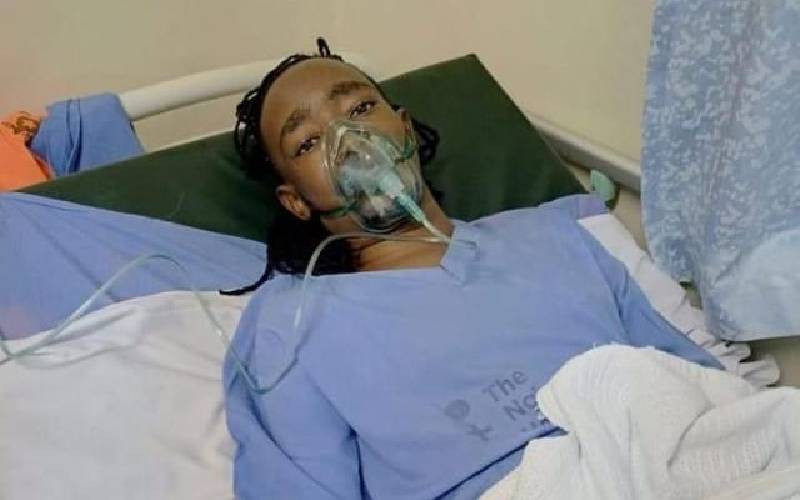NAIROBI: On February 17 this year, Evan, marked his 18th birthday. To say he was excited would be an understatement. The boy was over the moon.
He posted on his Facebook account: "Finally, through the grace of God, I turn 18 today, if I were any happier I would burst with joy.
Mum, I would like to thank you personally bcoz of your major contribution to my happiness and I love you for every single moment you have been there. I will now be accepting gifts and birthday wishes, YOLO!!!"
Reading the post brought tears to my eyes, and it still does each time I read it.
Evan is my son.
You see, Evan was born with sickle cell anaemia, an inherited form of anaemia — a condition where there are not enough healthy red blood cells to carry adequate oxygen throughout a person's body.
Normally, your red blood cells are flexible and round, moving easily through your blood vessels. In a case of sickle cell anaemia, the red blood cells become rigid and sticky and are shaped like sickles or crescent moons.
These irregularly shaped cells can get stuck in small blood vessels, which can slow or block blood flow and oxygen to parts of the body.
The lack of tissue oxygen can cause attacks of sudden, severe pain, called pain crises. These pain attacks can occur without warning, and a person often needs to go to the hospital for effective treatment.
Looking back over the years, I realise it has not been an easy journey. But I thank God for giving me grace to raise Evan, who will this year be sitting his Form Four exams.
Time taught me to accept that I had a special child, who needed special care and above all, love.
You see, I began this journey with very little information on the sickle cell disease.
At birth, Evan looked healthy like any other child. He reached his development milestones on time and nothing about his health prepared me for the bombshell I was to receive when he was nine months.
My mother, being a nurse, had her suspicions when the boy's hands and feet started swelling and had him tested for sickle cell. The test confirmed her worst fears but she hid the information from me.
When she finally got around to telling me about it, these were her words, "Ni kama Evan ako na sickle cell (It is like Evan has sickle cell)."
Stay informed. Subscribe to our newsletter
When you are told "ni kama" (it is like), you peg your hope on the fact that maybe it is not true. So I didn't take her seriously, and what bolstered my belief was that for a long time Evan was never sick. Things took a turn for the worse, when at about three, he got so sick that he had to be admitted to hospital.
The doctor who was treating him recommended a 'sickling' test given his symptoms; he had abdominal pain and anaemia.
It was this second test that confirmed my worst fears. And the doctor didn't help matters because during "counselling" he mentioned that most children with Evan's condition rarely lived to see their fifth birthday. For a long time, I was afraid to research the disease online.
That was a mistake.
With what I know now, I believe this journey would have been much better. With proper management, people with sickle cell anaemia can live a full life; go to school, get employed, marry or even have children.
It is important to know what triggers a crisis and how to avoid one from occurring; this includes dehydration, infection, fever and exposure to the cold.
Equally important is medication. Children with sickle cell disease mostly take folic acid and hydroxyurea. It also helps to join a support group.
Remember the popular adage that a problem shared is a problem solved?
KC Wafula, a doctor, introduced me to the Children Sickle Cell Foundation in 2013, which helps those living with sickle cell to cope positively with the emotional challenges that are a part of living with the disease.
So, as the world marks World Sickle Cell Awareness Day today and as a parent affected by this disease, I would like the Government; to recognise that sickle cell disease is a major health issue; increase awareness; eliminate harmful and wrong prejudices associated with the disease; establish health programmes at the national level, operate specialised centres and facilitate access to treatment; promote satisfactory access to medical services for people affected by sickle cell disease; provide technical support to prevent and manage it and promote and help research to improve the lives of people affected by the disease.
This is the least it can do for those battling sickle cell anaemia. They are warriors indeed.
 The Standard Group Plc is a
multi-media organization with investments in media platforms spanning newspaper
print operations, television, radio broadcasting, digital and online services. The
Standard Group is recognized as a leading multi-media house in Kenya with a key
influence in matters of national and international interest.
The Standard Group Plc is a
multi-media organization with investments in media platforms spanning newspaper
print operations, television, radio broadcasting, digital and online services. The
Standard Group is recognized as a leading multi-media house in Kenya with a key
influence in matters of national and international interest.
 The Standard Group Plc is a
multi-media organization with investments in media platforms spanning newspaper
print operations, television, radio broadcasting, digital and online services. The
Standard Group is recognized as a leading multi-media house in Kenya with a key
influence in matters of national and international interest.
The Standard Group Plc is a
multi-media organization with investments in media platforms spanning newspaper
print operations, television, radio broadcasting, digital and online services. The
Standard Group is recognized as a leading multi-media house in Kenya with a key
influence in matters of national and international interest.






